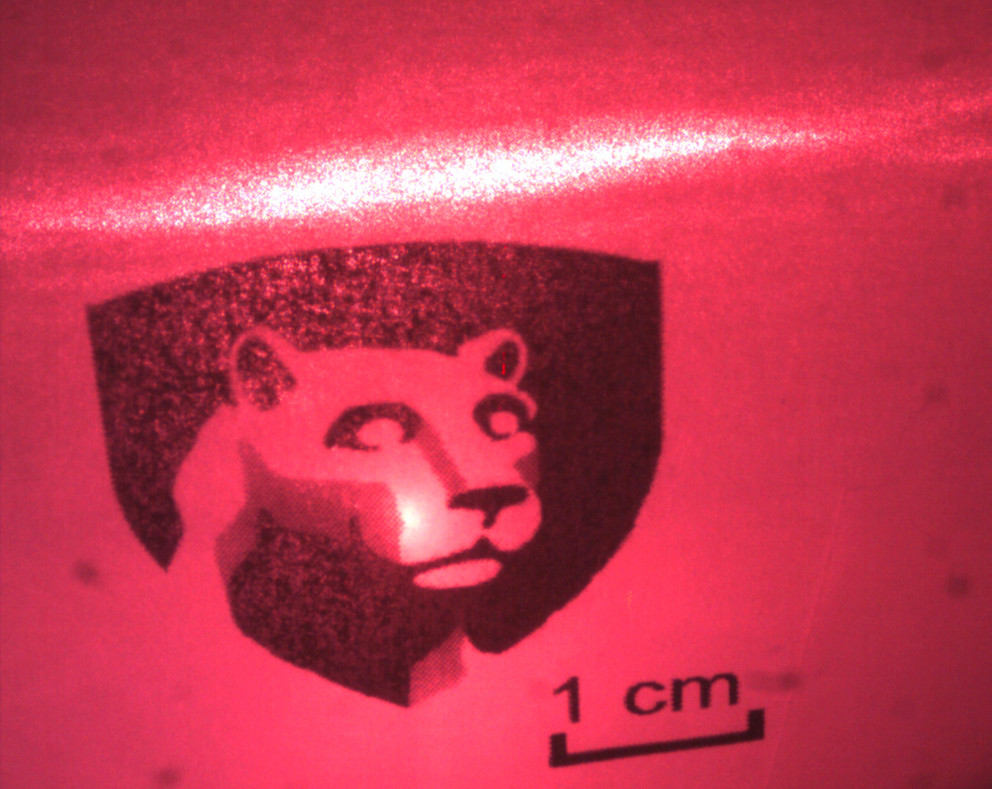Perovskite lasers are one step closer

Penn State and Princeton team report the first continuous-wave lasing in an organic-inorganic lead halide perovskite semiconductor
Researchers from Penn State and Princeton University have taken a step toward creating a diode laser from hybrid organic-inorganic perovskite - a material that can be deposited from solution on a laboratory benchtop.
"It's usually not a big leap to turn a light emitting diode into a laser," said Chris Giebink, assistant professor of electrical engineering, Penn State. "You essentially just add mirrors and drive it harder. Once organic LEDs were invented 30 years ago, everybody thought that as soon as we had relatively efficient OLEDs, that an organic laser diode would soon follow."
As it turned out, organic diode lasers proved to be really hard to make.
An organic laser diode could have advantages. First, because organic semiconductors are relatively soft and flexible, organic lasers could be incorporated into new form factors not possible for their inorganic counterparts. While inorganic semiconductor lasers are relatively limited in the wavelengths of light they emit, an organic laser can produce any wavelength a chemist cares to synthesise in the lab by tailoring the structure of the organic molecules. This tunability could be very useful in applications ranging from medical diagnostics to environmental sensing.
The key may well involve organic/inorganic perovskites. One of the reasons hybrid perovskite materials work so well in solar cells is that they are good light emitters. For that reason, they are also of interest for use in LEDs and lasers. The material Giebink and his colleagues are studying is composed of an inorganic perovskite sub-lattice with relatively big organic molecules confined in the middle.
"The ultimate goal is to make an electrically driven perovskite laser diode," said Giebink. "That would be a game changer. It is fairly easy to make the perovskite material lase by optical pumping, that is, by shining another laser on it. However, this has only worked for very short pulses due to a poorly understood phenomenon we call lasing death. Getting it to go continuously is a key step toward an eventual electrically driven device. What we found in this recent study is a curious quirk. We can avoid lasing death entirely just by lowering the temperature of the material a little bit to induce a partial phase transition."
In a paper published Nov. 20 in the journal Nature Photonics, Giebink and colleagues report the first 'Continuous-wave lasing in an organic-inorganic lead halide perovskite semiconductor.'
"When we lowered the temperature below the phase transition, we were surprised to find that the material initially emitted light from the low temperature phase, but then changed over within 100 nanoseconds and began lasing from the high-temperature phase "” for over an hour," said Yufei Jia, a graduate student in Giebink's lab and lead author. "It turned out that as the material heated up, although most of the material remained in the low-temperature phase, small pockets of the high-temperature phase formed, and that was where the lasing was coming from."
In some inorganic lasers, intensity of the lasing depends on how many charge carriers can be packed into the quantum wells. In the perovskite material, the arrangement of the high-temperature-phase inclusions inside the low temperature bulk seems to mimic these quantum wells and may play a role in enabling the continuous lasing.
"The jury is still out on this explanation," Giebink said. "It may be something more subtle."
Nevertheless, these results do point toward an opportunity to engineer a material that has the built-in qualities of this mixed phase arrangement, but without having to actually cool the material to low temperature. The current paper points to a couple of ideas for how those materials could be designed. The next big step then is to switch from optical pumping with an external laser to a perovskite laser diode that can be powered directly with electrical current.
"If we can solve the electrical pumping problem, perovskite lasers could turn into a technology with real commercial value," Giebink said.
In addition to Giebink and Jia, other contributors include Alex Grede, a graduate student in Giebink's lab, and Princeton assistant professor Barry Rand and his graduate student Ross Kerner.
The US Air Force Office of Scientific Research, the National Science Foundation, DARPA and the Office of Naval Research supported this work.


































